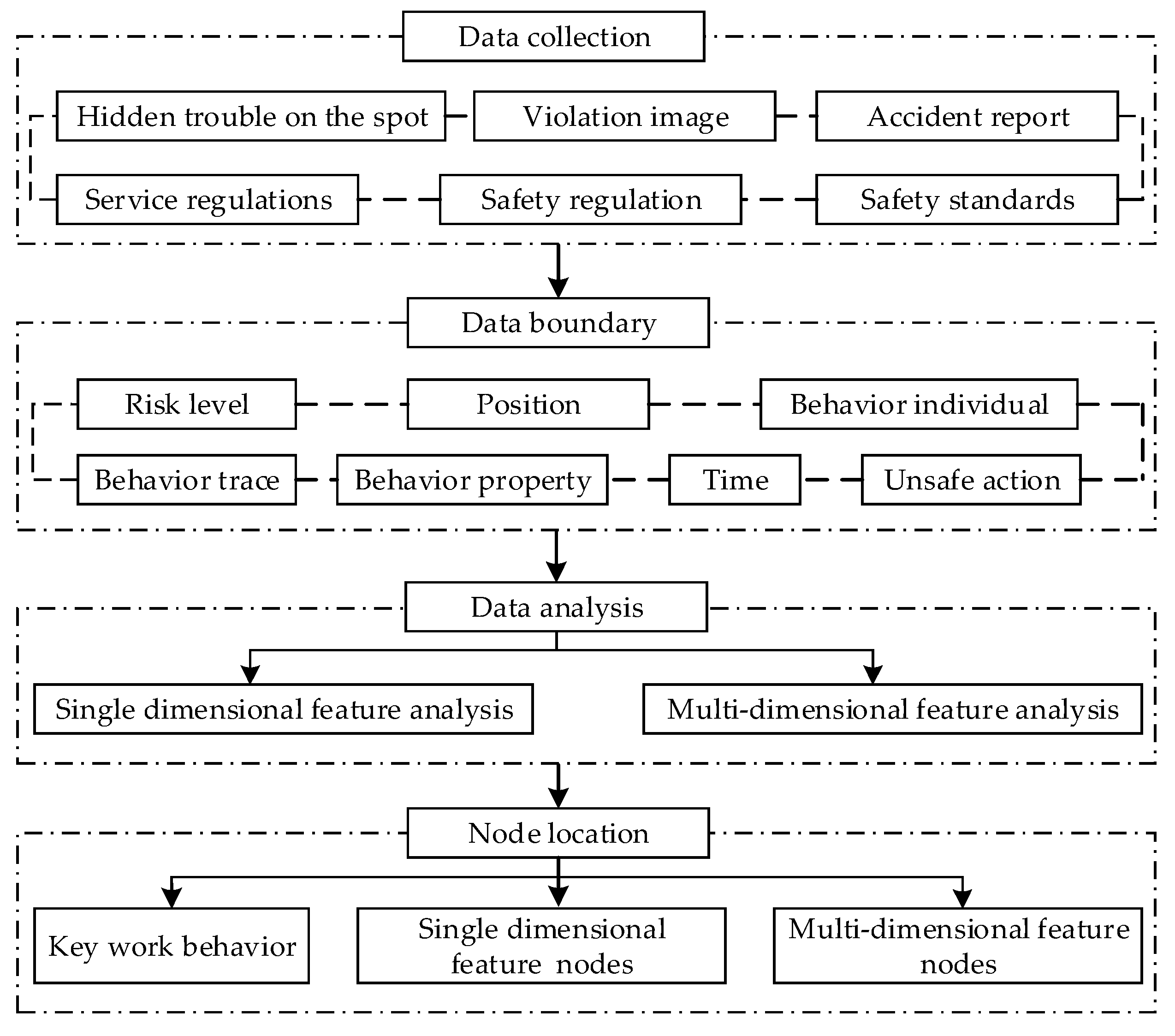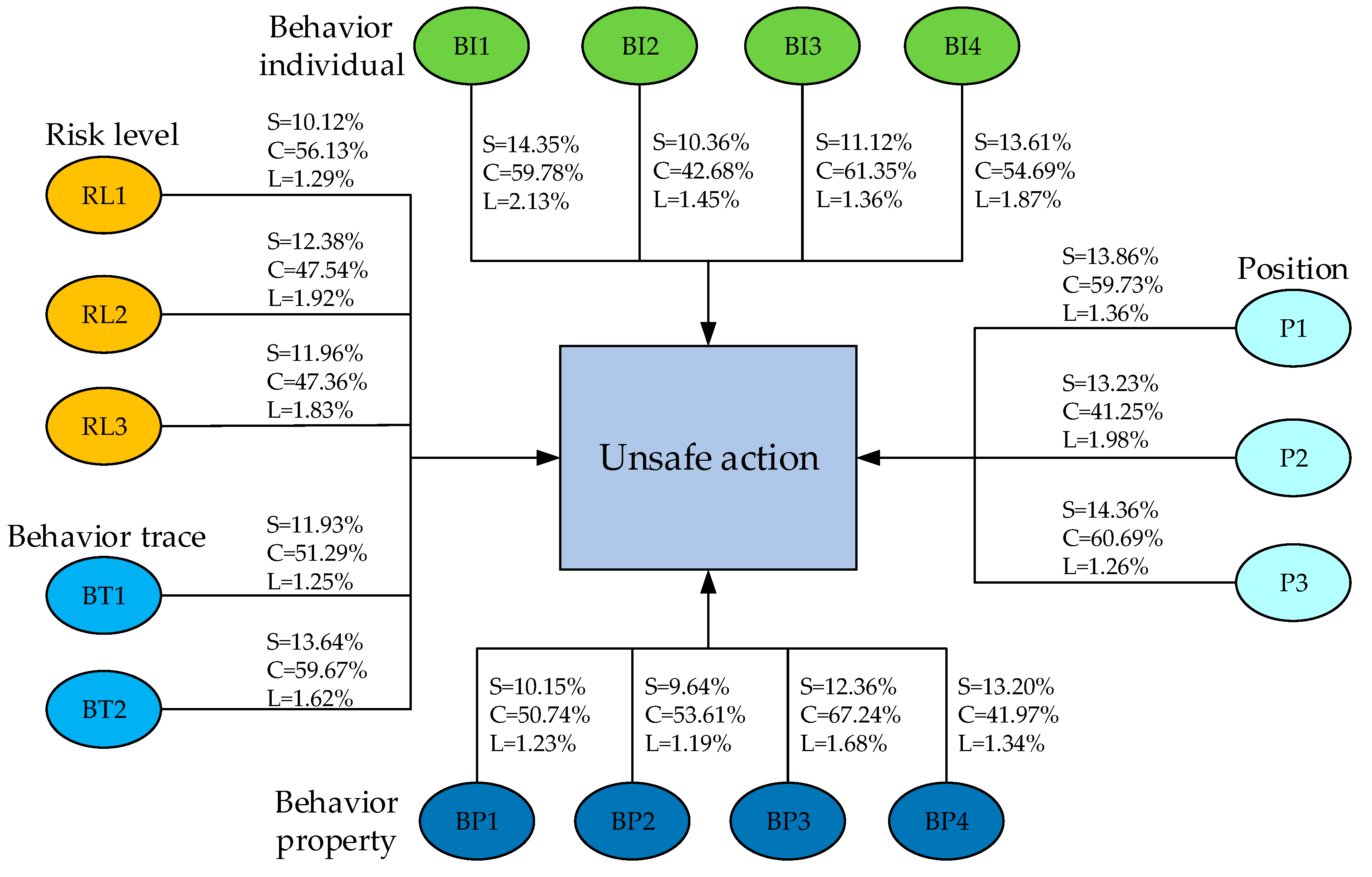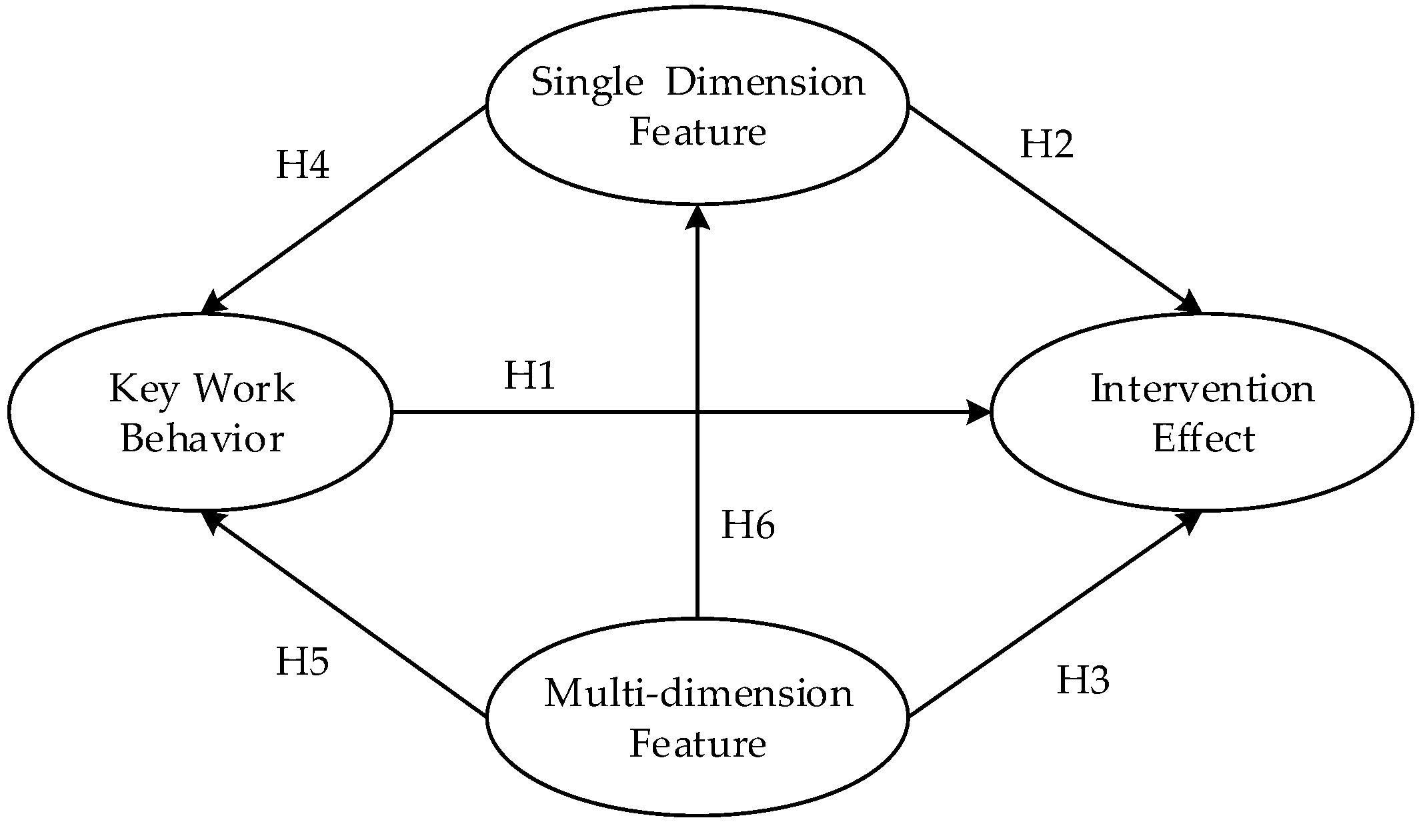Evaluating Targeted Intervention on Coal Miners’ Unsafe Behavior
Abstract
1. Introduction
2. The Targeted Intervention Nodes of Miners’ Unsafe Behavior
2.1. Data Sources
2.2. Data Boundary
2.3. Data Analysis
2.4. Locating Nodes
3. Research Methods
3.1. Unsafe Behavior Data Analysis Based on Roof Accidents
3.2. The Miners’ Unsafe Behavior Targeted Intervention Node Establishment
3.3. The Targeted Intervention Node Evaluation
3.3.1. Variable Division and Formulate Hypothesis
- H1. Key work behavior positively influences the intervention effect.
- H2. Single-dimensional features have a direct influence on the intervention effect.
- H3. Multi-dimensional features positively influence the intervention effect.
- H4. Single-dimensional features positively influence key work behavior.
- H5. Multi-dimensional features have a direct influence on key work behavior.
- H6. Multi-dimensional features have a direct influence on single-dimensional features.
3.3.2. Construct Model and Questionnaire Design
4. Result and Discussion
5. Conclusions
Author Contributions
Funding
Conflicts of Interest
References
- Jiang, W.; Qu, F.; Zhang, L. Quantitative identification and analysis on hazard sources of roof fall accident in coal mine. Procedia Eng. 2012, 45, 83–88. [Google Scholar] [CrossRef]
- Düzgün, H.S. Analysis of roof fall hazards and risk assessment for zonguldak coal basin underground mines. Int. J. Coal Geol. 2005, 64, 104–115. [Google Scholar] [CrossRef]
- Yang, D.F.; Zhang, L.F.; Chaim Li, B.; Bai, Y.F. Study of roof breaking law of fully mechanized top coal caving mining in ultra-thick coal seam based on fracture mechanics. Rock Soil Mech. 2016, 37, 2033–2039. [Google Scholar]
- Wang, W.; Luo, L.; Yu, W. Study of dynamic pressure roadway supporting scheme under condition of thick composite roof. J. Coal Sci. Eng. 2013, 19, 119–125. [Google Scholar] [CrossRef]
- Cooper, M. Exploratory Analyses of the Effects of Managerial Support and Feedback Consequences on Behavioral Safety Maintenance. J. Organ. Behav. Manag. 2006, 26, 1–41. [Google Scholar] [CrossRef]
- Paul, P.; Maiti, J. The role of behavioral factors on safety management in underground mines. Saf. Sci. 2007, 45, 449–471. [Google Scholar] [CrossRef]
- Chen, D.; Tian, H. Behavior based safety for accident prevention and positive study in China construction projects. Procedia Eng. 2012, 43, 528–534. [Google Scholar] [CrossRef]
- Di Bona, G.; Silvestri, A.; De Felice, F.; Forcina, A.; Petrillo, A. An Analytical Model to Measure the Effectiveness of Safety Management Systems: Global Safety Improve Risk Assessment (G-SIRA) Method. J. Fail. Anal. Prev. 2016, 16, 1–14. [Google Scholar] [CrossRef]
- Priebe, R.; Thomasolson, L. An exploration and analysis on the timeliness of critical incident stress management interventions in healthcare. Int. J. Emerg. Ment. Health 2013, 15, 39–49. [Google Scholar]
- Fogarty, G.; Shaw, A. Safety Climate and the Theory of Planned Behavior: Towards the Prediction of Unsafe Behavior. Accid. Anal. Prev. 2010, 42, 1455–1459. [Google Scholar] [CrossRef]
- Clarke, S. Contrasting perceptual, attitudinal and dispositional approaches to accident involvement in the workplace. Saf. Sci. 2006, 44, 537–550. [Google Scholar] [CrossRef]
- Aryee, S.; Hsiung, H. Regulatory focus and safety outcomes: An examination of the mediating influence of safety behavior. Saf. Sci. 2016, 86, 27–35. [Google Scholar] [CrossRef]
- Namian, M.; Albert, A.; Zuluaga, C.M.; Behm, M. Role of Safety Training: Impact on Hazard Recognition and Safety Risk Perception. J. Constr. Eng. Manag. 2016, 142, 04016073. [Google Scholar] [CrossRef]
- Kouabenan, D.; Ngueutsa, R.; Mbaye, S. Safety climate, perceived risk, and involvement in safety management. Saf. Sci. 2015, 77, 72–79. [Google Scholar] [CrossRef]
- Warszawska, K.; Kraslawski, A. Method for quantitative assessment of safety culture. J. Loss Prev. Process Ind. 2016, 42, 27–34. [Google Scholar] [CrossRef]
- Johnson, S.; Hall, A. The prediction of safe lifting behavior: An application of the theory of planned behavior. J. Saf. Res. 2005, 36, 63–73. [Google Scholar] [CrossRef] [PubMed]
- Lee, Y.S.; Kim, Y.; Kim, S.H.; Kim, C.; Chung, C.H.; Jung, W.D. Analysis of human error and organizational deficiency in events considering risk significance. Nucl. Eng. Des. 2004, 230, 61–67. [Google Scholar] [CrossRef]
- Geller, E. Behavior-based safety and occupational risk management. Behav. Modif. 2005, 29, 539. [Google Scholar] [CrossRef]
- Tong, R.; Chen, C.; Liu, S.; Lu, H.; Ma, J. Research on theory and application of pan-scene data for behavioral safety. China Saf. Sci. J. 2017, 27, 1–6. [Google Scholar] [CrossRef]
- Mahdevari, S.; Shahriar, K.; Esfahanipour, A. Human health and safety risks management in underground coal mines using fuzzy TOPSIS. Sci. Total Environ. 2014, 488, 85–99. [Google Scholar] [CrossRef]
- Tong, R.; Zhang, Y.; Cui, P.; Zhai, C.; Shi, M.; Xu, S. Characteristic analysis of unsafe behavior by coal miners: Multi-dimensional description of the pan-Scene data. Int. J. Environ. Res. Public Health 2018, 15. [Google Scholar] [CrossRef] [PubMed]
- Yin, W.; Fu, G.; Yang, C.; Jiang, Z.; Zhu, K.; Gao, Y. Fatal gas explosion accidents on Chinese coal mines and the characteristics of unsafe behaviors: 2000–2014. Saf. Sci. 2017, 92, 173–179. [Google Scholar] [CrossRef]
- Rocha, R.; Mollo, V.; Daniellou, F. Work debate spaces: A tool for developing a participatory safety management. Appl. Ergon. 2015, 46, 107–114. [Google Scholar] [CrossRef] [PubMed]
- Qing-Gui, C.; Kai, L.; Ye-Jiao, L.; Qi-Hua, S.; Jian, Z. Risk Management and Workers’ Safety Behavior Control in Coal Mines. Int. Symp. Mine Saf. Sci. Eng. 2012, 50, 909–913. [Google Scholar] [CrossRef]
- Kumar, S.; Toshniwal, D. A data mining framework to analyze road accident data. J. Big Data 2015, 2, 26. [Google Scholar] [CrossRef]
- Verma, A.; Khan, S.D.; Maiti, J.; Krishna, O.B. Identifying patterns of safety related incidents in a steel plant using association rule mining of incident investigation reports. Saf. Sci. 2014, 70, 89–98. [Google Scholar] [CrossRef]
- Montella, A. Identifying crash contributory factors at urban roundabouts and using association rules to explore their relationships to different crash types. Accid. Anal. Prev. 2011, 43, 1451–1463. [Google Scholar] [CrossRef] [PubMed]
- Guo, S.Y.; Ding, L.Y.; Luo, H.B.; Jiang, X.Y. A Big-Data-based platform of workers’ behavior: Observations from the field. Accid. Anal. Prev. 2016, 93, 299–309. [Google Scholar] [CrossRef]
- Eriksson, P.; Larsson, J.; Ossi, P. Managing complex projects in the infrastructure sector-A structural equation model for flexibility-focused project management. Int. J. Proj. Manag. 2017, 35, 1512–1523. [Google Scholar] [CrossRef]
- Iacobucci, D. Structural equations modeling: Fit Indices, sample size, and advanced topics. J. Consum. Psychol. 2010, 20, 90–98. [Google Scholar] [CrossRef]
- Arocena, P.; Nunez, I. An empirical analysis of the effectiveness of occupational health and safety management systems in SMEs. Int. Small Bus. J. 2010, 28, 398–419. [Google Scholar] [CrossRef]
- Morrow, S.L.; McGonagle, A.K.; Dove-Steinkamp, M.L.; Walker, C.T.; Marmet, M.; Barnes-Farrell, J.L. Relationships between psychological safety climate facets and safety behavior in the rail industry: A dominance analysis. Accid. Anal. Prev. 2010, 42, 1460–1467. [Google Scholar] [CrossRef]
- Li, H.; Lu, M.; Hsu, S.C.; Gray, M.; Huang, T. Proactive behavior-based safety management for construction safety improvement. Saf. Sci. 2015, 75, 107–117. [Google Scholar] [CrossRef]
- Zohar, D. Thirty years of safety climate research: Reflections and future directions. Accid. Anal. Prev. 2010, 42, 1517–1522. [Google Scholar] [CrossRef]
- Leung, S. A Comparison of Psychometric Properties and Normality in 4-, 5-, 6-, and 11-Point Likert Scales. J. Soc. Serv. Res. 2011, 37, 412–421. [Google Scholar] [CrossRef]
- Guo, B.; Yiu, T.; Vicente, A. Predicting safety behavior in the construction industry: Development and test of an integrative model. Saf. Sci. 2016, 84, 1–11. [Google Scholar] [CrossRef]
- De, W.; Dodou, D. The driver behavior questionnaire as a predictor of accidents: A meta-analysis. J. Saf. Res. 2010, 41, 463–470. [Google Scholar] [CrossRef]
- Ho, C.; Dzeng, R. Construction safety training via e-Learning: Learning effectiveness and user satisfaction. Comput. Educ. 2010, 55, 858–867. [Google Scholar] [CrossRef]
- Rosenbloom, T.; Wultz, B. Thirty-day self-reported risky driving behaviors of ADHD and non-ADHD drivers. Accid. Anal. Prev. 2011, 43, 128–133. [Google Scholar] [CrossRef]
- Zaira, M.; Hadikusumo, B. Structural equation model of integrated safety intervention practices affecting the safety behavior of workers in the construction industry. Saf. Sci. 2017, 98, 124–135. [Google Scholar] [CrossRef]
- Lenné, M.G.; Salmon, P.M.; Liu, C.C.; Trotter, M. A systems approach to accident causation in mining: An application of the HFACS method. Accid. Anal. Prev. 2012, 48, 111–117. [Google Scholar] [CrossRef] [PubMed]
- Komaki, J.; Barwick, K.; Scott, L. A behavioral approach to occupational safety: Pinpointing and reinforcing safe performance in a food manufacturing plant. J. Appl. Psychol. 1978, 63, 434–445. [Google Scholar] [CrossRef] [PubMed]
- Li, S.; Liu, H.; Yang, Y. Model of Coal Safety Prediction and Evaluation Based on Miners’ Unsafe Behavior. Saf. Coal Mines 2017, 48, 242–245. [Google Scholar]
- Luria, G.; Zohar, D.; Erev, I. The effect of workers’ visibility on effectiveness of intervention programs: Supervisory-based safety interventions. J. Saf. Res. 2008, 39, 273–280. [Google Scholar] [CrossRef] [PubMed]
- Di Bona, G.; Silvestri, A.; Forcina, A.; Petrillo, A. Total efficient risk priority number (TERPN): A new method for risk assessment. J. Risk Res. 2017, 1–25. [Google Scholar] [CrossRef]
- Cheng, C.W.; Leu, S.S.; Lin, C.C.; Fan, C. Characteristic analysis of occupational accidents at small construction enterprises. Saf. Sci. 2010, 48, 698–707. [Google Scholar] [CrossRef]
- Chen, H.; Qi, H.; Long, R.; Zhang, M. Research on 10-year tendency of China coal mine accidents and the characteristics of human factors. Saf. Sci. 2012, 50, 745–750. [Google Scholar] [CrossRef]
- Sanmiquel, L.; Rossell, J.; Vintró, C. Study of Spanish mining accidents using data mining techniques. Saf. Sci. 2015, 75, 49–55. [Google Scholar] [CrossRef]
- Parker, A.; Tones, M.; Ritchie, G. Development of a multilevel health and safety climate survey tool within a mining setting. J. Saf. Res. 2017, 62, 173–180. [Google Scholar] [CrossRef]
- Mohammadfam, I.; Kamalinia, M.; Momeni, M.; Golmohammadi, R.; Hamidi, Y.; Soltanian, A. Evaluation of the Quality of Occupational Health and Safety Management Systems Based on Key Performance Indicators in Certified Organizations. Saf. Health Work 2017, 8, 156–161. [Google Scholar] [CrossRef]
- Haghighi, M.; Taghdisi, M.H.; Nadrian, H.; Moghaddam, H.R.; Mahmoodi, H.; Alimohammadi, I. Safety culture promotion intervention program (SCPIP) in an oil refinery factory: An integrated application of geller and health belief models. Saf. Sci. 2017, 93, 76–85. [Google Scholar] [CrossRef]
- Amiri, M.; Ardeshir, A.; Fazel Zarandi, M.H.; Soltanaghaei, E. Pattern extraction for high-risk accidents in the construction industry: A data-mining approach. Int. J. Injury Control Saf. Promot. 2016, 23, 264–276. [Google Scholar] [CrossRef] [PubMed]
- Cheng, C.; Yao, H.; Wu, T. Applying data mining techniques to analyze the causes of major occupational accidents in the petrochemical industry. J. Loss Prev. Process Ind. 2013, 26, 1269–1278. [Google Scholar] [CrossRef]




| Dimensional | Result (Frequency, Scale) |
|---|---|
| RL | High-risk (456, 37.5%); medium-risk (539, 44.4%); low-risk (220, 18.1%) |
| P | Coal face (504, 41.5%); tunneling working site (333, 27.4%); main roadway (198, 16.3%); others (180, 14.8%) |
| UA | Supporting (190, 18.36%); safety inspection (119, 11.50%); general type (114, 11.01%) |
| BI | Coal mining worker (628, 51.7%); field commanders (213, 17.5%); middle management staff (255, 21.0%); senior management staff (119, 9.8%) |
| BT | Traced behavior (574, 47.2%); non-traced behavior (641, 52.8%) |
| BP | Violation of action (706, 62.5%); violation of operation (316, 26.0%); violation of command (70, 1.4%); non-violation unsafe action (123, 10.1%) |
| T | More unsafe actions occur in January, March, and August. |
| Dimension | Antecedent | Consequent | Association Rule |
|---|---|---|---|
| RL | High-risk | Empty roof operation | Different risk levels correspond to the most frequent miners’ unsafe action |
| Medium-risk | No safety measures | ||
| Low-risk | Failure to clean up float coal in time | ||
| P | Coal face | Inadequate supporting | Different workplaces correspond to the most frequent miners’ unsafe action |
| Tunneling working site | Empty roof operation | ||
| Main roadway | Failure to strengthen roadway support | ||
| BI | Coal mining worker | Empty roof operation | Different behavior individuals correspond to the most frequent miners’ unsafe action |
| Field commanders | Inadequate supporting | ||
| Middle management staff | No site supervision of the workers’ work | ||
| Senior management staff | Illegal organization of production | ||
| BT | Traced behavior | Inadequate supporting | The most frequent occurrence of the traced unsafe behavior is failure to support in time |
| Non-traced behavior | The surrounding environment was not checked before the operation | The most frequent occurrence of the traced unsafe behavior is failure to check the surrounding environment before the operation | |
| BP | Violation of action | Empty roof operation | Different behavior properties correspond to the most frequent miners’ unsafe action |
| Violation of operation | Inadequate supporting | ||
| Violation of command | Illegal organization of production | ||
| Non-violation unsafe action | Nocking and drumming before the work are not careful |
| Types | Lable | Contents | |
|---|---|---|---|
| Key Work Behavior K | K1 | Coal mining worker | Work under the empty roof |
| K2 | Safety inspection worker | No inspection of the working surface roof safety condition before the operation | |
| K3 | Survey worker | The geological data around the coal mine were not updated in time | |
| K4 | Field commander | No inspection of the work on the working field | |
| K5 | Middle management staff | Safety technical measures were not made according to the situation of the working field before operation | |
| K6 | Senior management staff | Illegal organization of production | |
| Single-Dimensional Feature S | S1 | Medium-risk > High-risk > Low-risk | Rational allocation of management resources according to the frequency of different risk behaviors |
| S2 | Coal face > Tunneling working site > main roadway > Others | Focus on observing coal face, tunneling working site, and roadway in daily behavior safety management | |
| S3 | Supporting > Safety inspection > General type | Increasing the intervention of supporting and safety inspection work in daily behavior safety management | |
| S4 | Coal mining worker > Middle management staff > Field commanders > Senior management staff | Rational allocation of safety training resources according to the frequency of different workers | |
| S5 | Non-traced behavior > Traced behavior | More attention paid to the observation of non-traced behavior in daily safety management | |
| S6 | Violation of action > Violation of operation > Non-violation unsafe action > Violation of command | Rational allocation of safety training and management resources according to the frequency of different workers | |
| S7 | January, March, August | More attention paid in January, March, and August to safety management work | |
| Multi-Dimensional Feature M | M1 | High-risk → Empty roof operation | Emphasis placed on “controlling the empty roof operation” when intervening in high-risk behavior |
| M2 | Coal face → Inadequate supporting | Emphasis placed on “inadequate supporting” during the safety inspection at coal face | |
| M3 | Main roadway→Failure to strengthen roadway support | Emphasis placed on “failure to strengthen roadway support” during the safety inspection at main roadway | |
| M4 | Traced behavior → Inadequate supporting | Emphasis placed on “inadequate supporting” when intervening in traced behavior | |
| M5 | Non-traced behavior →The Surrounding environment was not checked before the operation | Emphasis placed on “surrounding environment” “not checked before the operation” when intervening in non-traced behavior | |
| M6 | Violation of command → Illegal organization of production | Emphasis placed on “illegal organization of production” when intervening the violation of command | |
| Latent Variable | Cronbach’s α | Cronbach’s α Based on Standardization Term | Number of Terms |
|---|---|---|---|
| Key work behavior node | 0.813 | 0.837 | 6 |
| Single-dimensional feature node | 0.824 | 0.841 | 7 |
| Multi-dimensional feature node | 0.796 | 0.805 | 6 |
| Intervention effect | 0.811 | 0.828 | 3 |
| Criteria | X2/df | RMSEA | NFI | RFI | IFI | TLI | CFI | PGFI |
|---|---|---|---|---|---|---|---|---|
| Fit Index | <3 | <0.08 | >0.9 | >0.9 | >0.9 | >0.9 | >0.9 | >0.5 |
| Model Index | 3.062 | 0.068 | 0.923 | 0.906 | 0.912 | 0.956 | 0.914 | 0.587 |
© 2019 by the authors. Licensee MDPI, Basel, Switzerland. This article is an open access article distributed under the terms and conditions of the Creative Commons Attribution (CC BY) license (http://creativecommons.org/licenses/by/4.0/).
Share and Cite
Tong, R.; Zhang, Y.; Yang, Y.; Jia, Q.; Ma, X.; Shao, G. Evaluating Targeted Intervention on Coal Miners’ Unsafe Behavior. Int. J. Environ. Res. Public Health 2019, 16, 422. https://doi.org/10.3390/ijerph16030422
Tong R, Zhang Y, Yang Y, Jia Q, Ma X, Shao G. Evaluating Targeted Intervention on Coal Miners’ Unsafe Behavior. International Journal of Environmental Research and Public Health. 2019; 16(3):422. https://doi.org/10.3390/ijerph16030422
Chicago/Turabian StyleTong, Ruipeng, Yanwei Zhang, Yunyun Yang, Qingli Jia, Xiaofei Ma, and Guohua Shao. 2019. "Evaluating Targeted Intervention on Coal Miners’ Unsafe Behavior" International Journal of Environmental Research and Public Health 16, no. 3: 422. https://doi.org/10.3390/ijerph16030422
APA StyleTong, R., Zhang, Y., Yang, Y., Jia, Q., Ma, X., & Shao, G. (2019). Evaluating Targeted Intervention on Coal Miners’ Unsafe Behavior. International Journal of Environmental Research and Public Health, 16(3), 422. https://doi.org/10.3390/ijerph16030422






